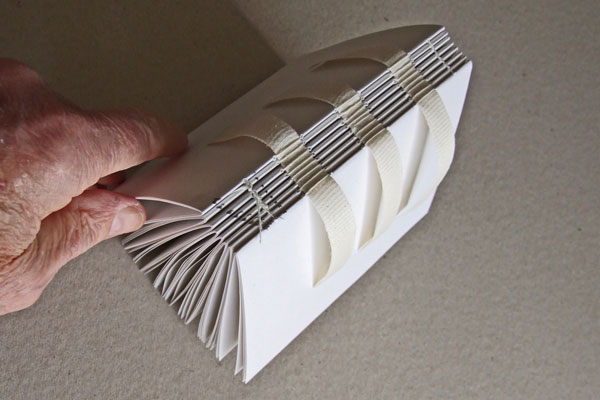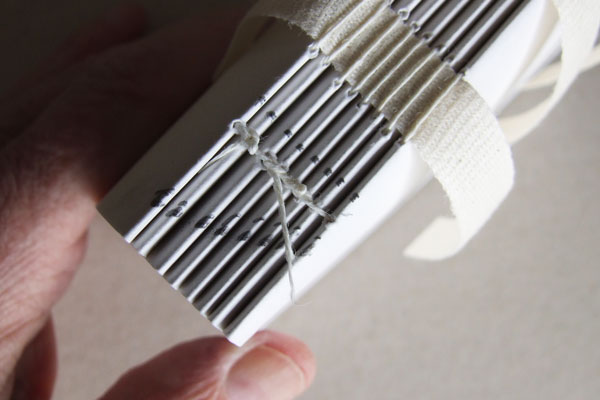
A part-made book ~ sewn on tapes ~ showing eight sections
Sewn books are made up from folded papers gathered into small bundles ~ sections and these are sewn together through the hinge. It is difficult to stitch through lots of pages at once ~ nor is it easy to fold them neatly ~ and so the number of sheets in a section is usually limited to four ~ or eight ~ or sixteen [126638].

Whilst a book is being made, the pages are gathered into conveniently sized bundles which are called sections. A large book will contain several, or many, such gatherings, depending on the extent of the book.
The bindery will decide how many pages are to go into each section, depending on the type of paper, the type of binding required, the binder's preference. Most importantly it has to be notified to the printer so that the appropriate imposition can be chosen. I suspect that this is forgotten, or ignored, outside the trades...but...I am wandering away from the matter in hand...I start again...or advise browsing elsewhere.
The easiest way to describe the making a sewn book is to start by imagining a pile of plain paper sheets. If the sheets are to be sewn and bound in the codex style then each sheet needs to be folded in half. This gives four book pages ~ as they are usually numbered.
The book will be half the size of the starting sheets. If you want an A5 sized book then you have to start with a pile of A4 sheets of paper. If you want an A4 sized book then you will need to start with an A3 sheet. America has not widely adopted the ISO 'A' series of sizes, and readers unfamiliar with it may need an explanation [113021].
The number of folios in each section is determined by several factors. When publishing books the size of the printing press is critical. Setting-up the press is time consuming. It is expensive, and takes as much time to print and set-up one page as eight. If the press is large enough then eight, or sixteen, pages can be conveniently printed on each side of the sheet. Each sheet is folded in half, and half again, until the final size is reached. Some of the folds are then slit, or maybe they are all guillotined, later.
The bundles of sections are carefully assembled in order. Since they are usually printed and stored in separate piles all over the workshop, the order of gathering them together is very important. This is made simpler for the staff by providing codes, which are of two main types.
Prior to printing the front page of every section is numbered, or lettered, such that 1,2,3... or A,B,C...AA,BB... This is usually done with an insignifican mark in bottom left gutter of the front page of each section. Assembly is in that way made fault free, and the gatherer does not have to read the last sentence of section 5 to make sure the first sentence of page 6 follows on, or that page 33 follows page 31.
The other technique is to print tiny marks on the hinge of each section. These can be numbers, or more usually a set of staggered black marks. These are hidden once the book is bound.

The marks on each section are called signatures. The two emboldened words in that sentence are self explanatory, and yet have become so confused that they are now synonymous. Some people, I think only few, are purists over this. Hence the purpose of this note is to be aware of the different interpretation. Many (?most? - I am not that well read) modern authors treat the words as synonymous, indeed "section" is little used. (I think it is mostly prevalent amongst American authors.) Don't spend time fretting or commenting on this, just interpret either word as the context requires.
